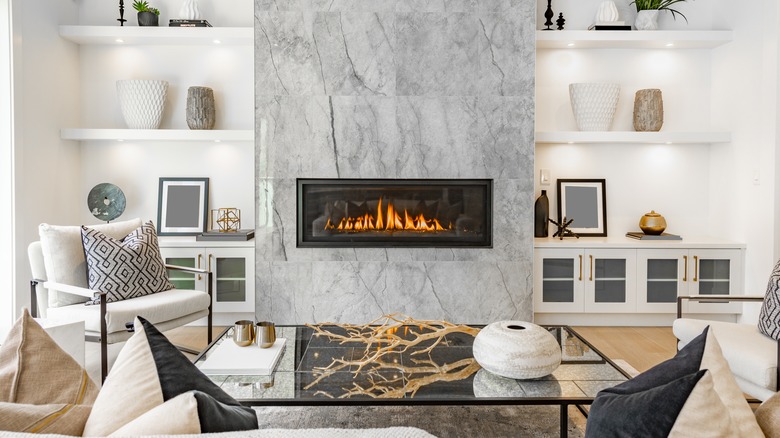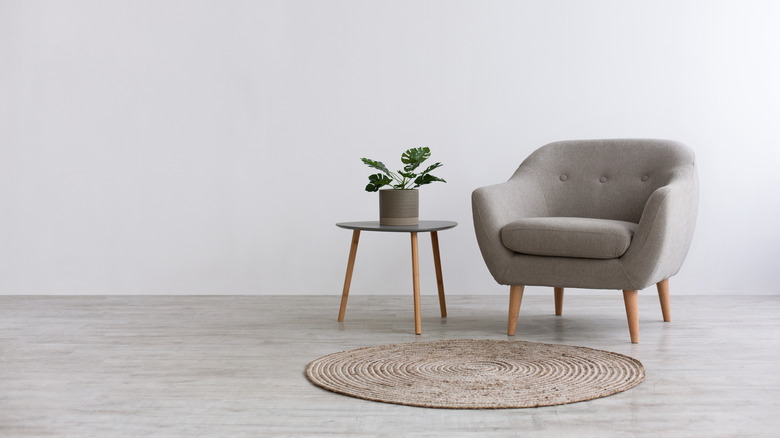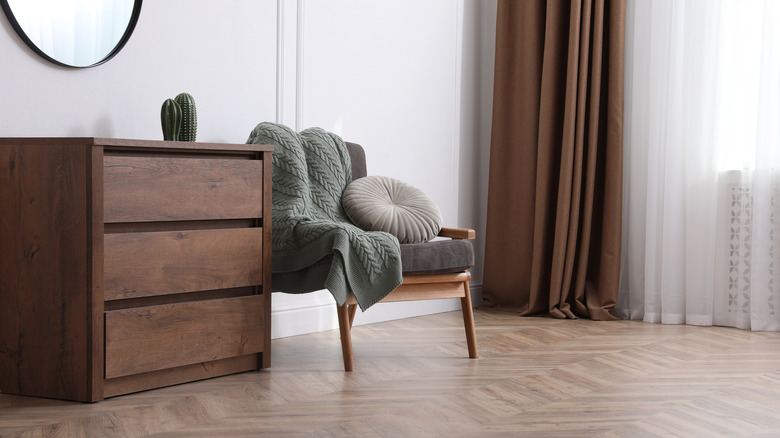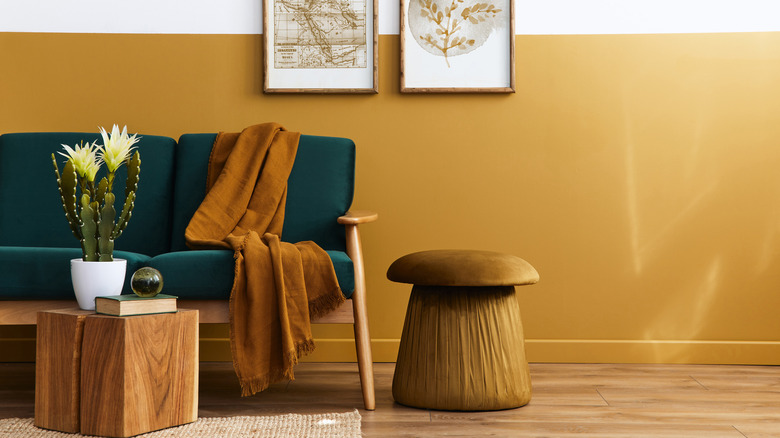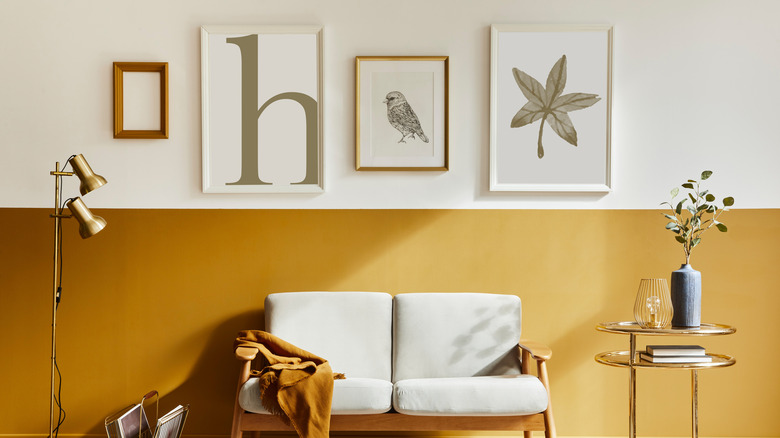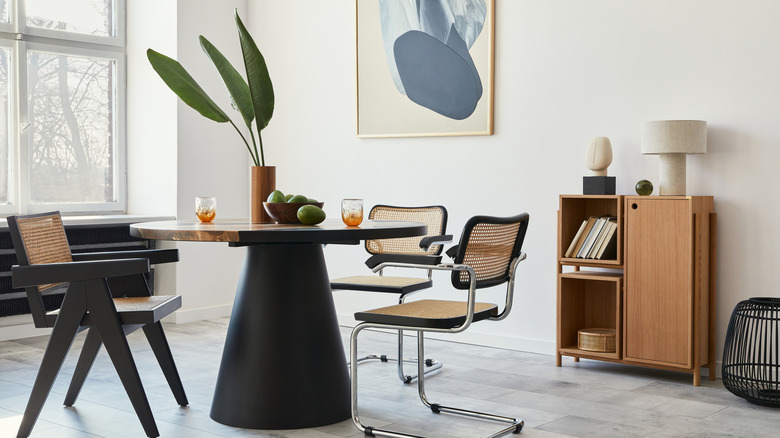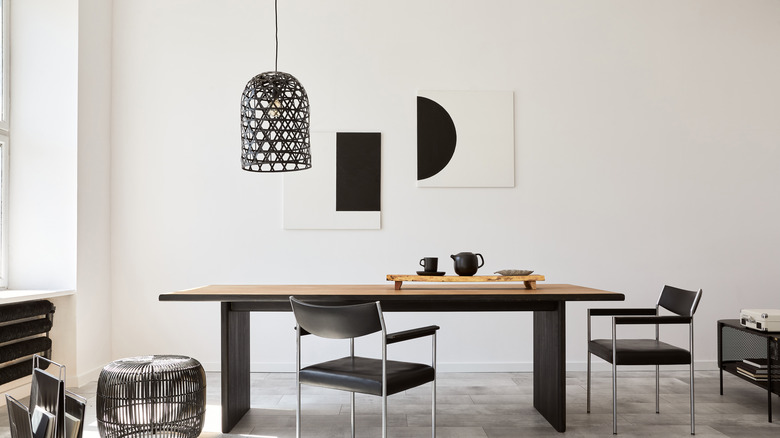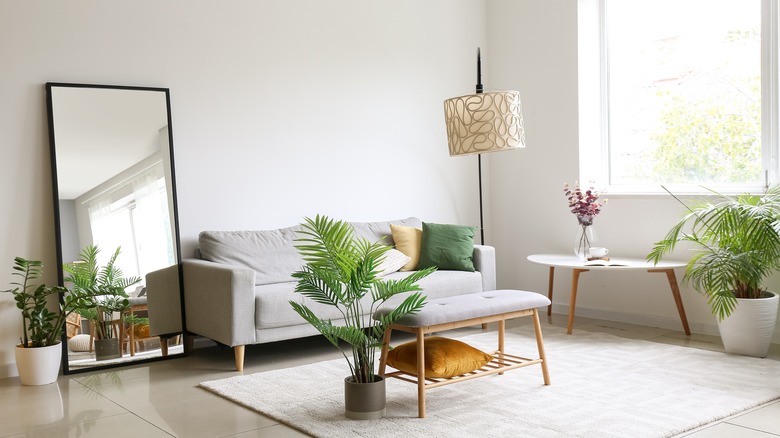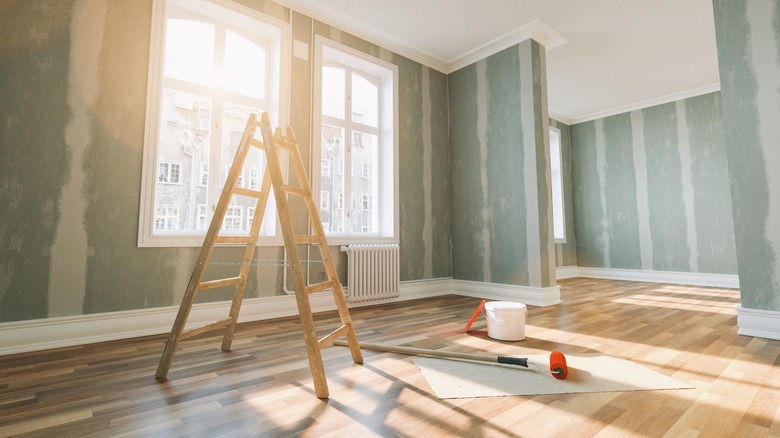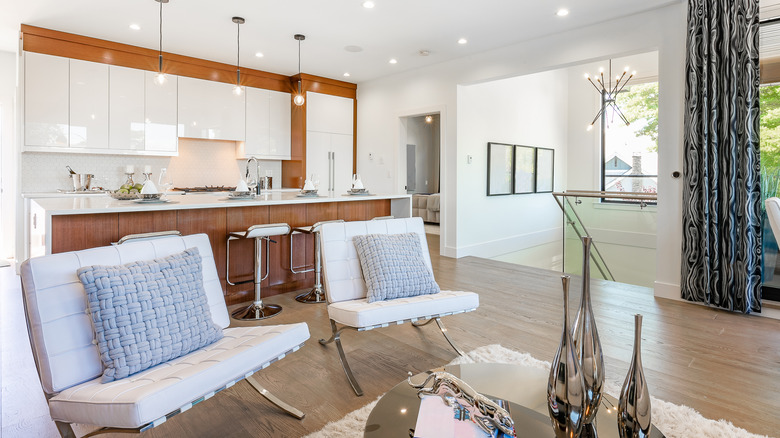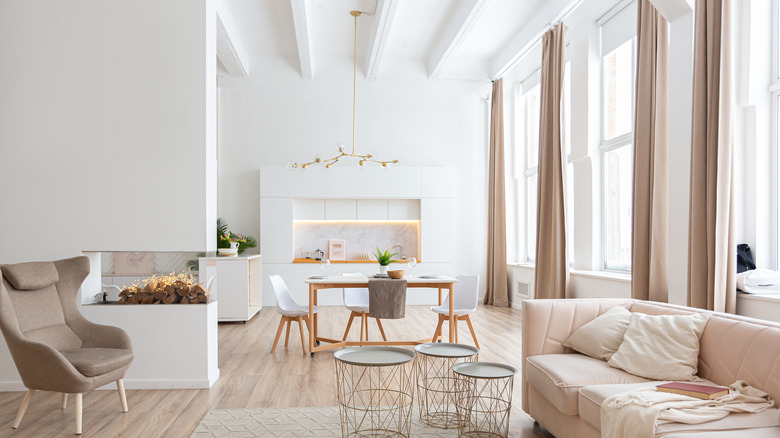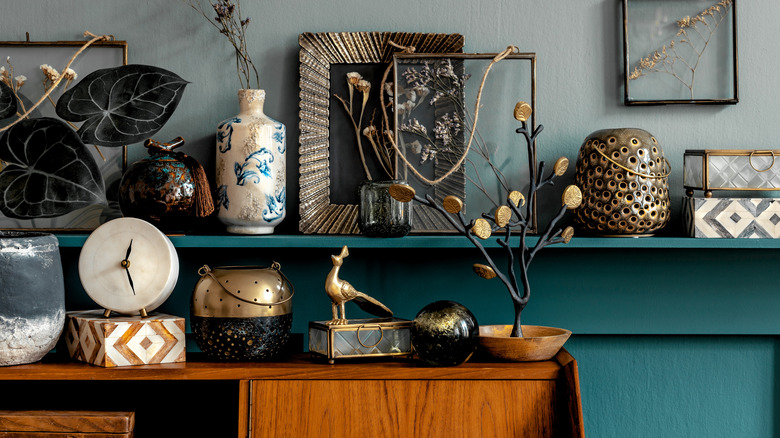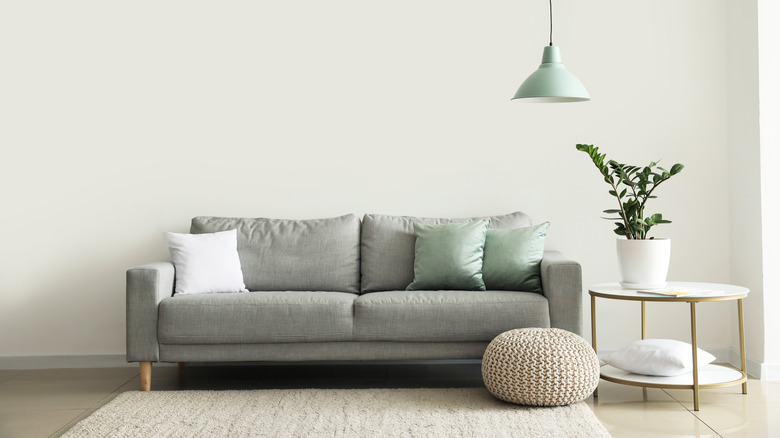Where To Start When Decorating A New Home From Scratch
We may receive a commission on purchases made from links.
Are you moving into a new place or planning to redecorate an existing space? With so many decor options to choose from, filling a home when it's completely empty can seem a little daunting. Rather than retreating into your usual ways, utilize fresh energy in your new place to curate a timeless interior you'll love to live in for a long time. Before you begin unpacking all your belongings or choosing what color to paint the walls, take a moment to first embrace your space.
Decorating a home requires finding balance among the textures, colors, patterns, and tones you use. "There are no rights nor wrongs in interior design," Vanessa Arbuthnott told Ideal Home. "It's just a matter of getting an eye for it. Remember that you are in control, taking the latest trends into account is worthwhile but always put your personal spin on something to make it special. Your home is where you spend most of your time, so the space needs to reflect you," she continued. Don't feel overwhelmed — instead, be inspired. You'll soon discover how decorating a home from scratch is easy and enjoyable, all with a little help and inspiration from the tips below.
Bare bones can be beautiful
Sometimes, less is more. An empty home gives new dwellers time to enjoy its bare bones and decide on how they want to live in the space — something you can't possibly know before moving in. Use the emptiness as an opportunity to highlight your house's best features. "The home is a statement in itself before you even start to decorate," interior designer and architect Peter Sheehan told Homes & Gardens. If you're starting from scratch, try to use the home's existing features as elements of decor, and promote the parts you love the most before filling the space with furniture and other items.
Begin by finding ways to enhance the home's architectural details — like stained white oak ceiling beams, crown molding, or unique doors — to be all the decorative statements you need. Perhaps there are archways you love, window moldings you want to emphasize, or french doors you simply do not want to hide behind a wall of curtains. Accentuating the home's structural features adds elegance and visual interest to a room, without additional decor taking up space. Choose to highlight the structural features in your home and celebrate what is already stunning all on its own.
Decide on what you don't like
When decorating a home from scratch, it may seem easier to point out what decor you don't want, rather than what items you do want to include. According to an interview on TIME with interior designer Grant K. Gibson, taking some time to figure this out helps you to really hone in on your preferred taste. It wouldn't be abnormal for you to say "no" multiple times before you finally say "yes" to something for the interior — and that's okay! By first determining your personal dislikes, you can then redirect your focus to singling out items that you're excited about.
Go ahead and fill your empty nest with decorative components that are genuinely pleasant for you, your family, and your guests to be around and use. Eliminate or pass on the chairs, rugs, tables, knitted poufs, and lamps that simply don't go with the new vibe in your household. Take note of the colors that make you happy and the furniture pieces that accommodate how you entertain. When designing a blank-slate interior, select what feels right by knowing what you don't like for your digs.
Choose a trio of colors
If creating a color palette with multiple shades for every room gets too overwhelming to do at once, don't feel pressured into doing so just yet. With a design that's being built from the ground up, try to focus your decorative attention on selecting only a few colors that go well together across your entire space. How many colors should you include when beginning a design from scratch? Let's check in with the pros.
Principal designer at BHDM Design, Dan Mazzarini, told Clare, "I also love to use color in triads. The color wheel has so many complementary colors but the triangulation of color seems to always be pleasing to the eye." Begin your look with a trio of complementary colors to establish a cohesive scheme across the entire interior landscape, from the living room and the kitchen, to the dining area and the bedrooms. For an effortlessly chic appearance, choose three shades with undertones that go well together, such gray, white, and black; teal, magenta, and gold; or even blue, green, and gray. Having a base palette to use throughout the house provides a unified range of pigmentation across the aesthetic. You can continue building on your base of colors by adding other shades that go well together.
Pick out some unique picture frames
While the art you choose to display on your walls is important, so are the frames the art pieces hang in. You want both to be equally as pleasing to look at. Wall art is used to enhance a space, so it's important to choose frames that stimulate visual interest, while still complementing the rest of the decor in the room. When decorating from scratch, you should carefully select picture frames by paying attention to the materials and colors, and making sure they are aligned with not just the art, but the room they'll be going in.
Mary Patton of Mary Patton Design told Better Homes & Gardens,"Picture frames come in many variations in terms of materials. I love mixing sleek brass ones with wood options." But that's not the only combination available to new home decorators, as plastic, varying types and colors of wood, and metal frames are all options. The ones you choose will depend on your style. Wood add a subtle softness to the walls, whereas black metal delivers a contemporary, crisp finish, and gold antique frames — like this one available on Amazon – introduce a nostalgic, vintage vibe. Combine a few unique styles in multiple sizes throughout your home to give character to an ordinary space.
Mix materials
Mix, rather than match, when decorating your interior. We're not talking about just the picture frames on the walls, but furniture and accessories, too. If done correctly, mixing materials is a good starting point for beginning to fill in an empty space, because it assists in bridging a cohesive design. Not such an easy task for those beginning with blank chambers, but it's achievable if you focus on matching the tones of your items (via Kathy Kuo Home).
Whether you have an open floor plan, studio apartment, or a multi-level home, mix and match materials — wicker, glass, wood, etc. — in every room. When you're shopping for furniture, purchase pieces intentionally and blend them together in one area of the house. Mixing wood and metal finishes creates a vibrant new energy in a space. The combination of a shiny sheen and a warm wood makes for a beautiful cohesive pairing that can elevate any style preference, from contemporary to farmhouse. Update woods and metals with marble table tops, like this one at Wayfair, or add metallic decorations to establish a more carefully-curated aesthetic.
Mix the colors in your art
With a completely blank canvas, anything is possible. Look at the walls in your home as just that — blank canvases — and create masterpieces throughout your residence by adorning them with art that helps tie together your color palette and connect multiple rooms. Cover your walls with neutral, muted, or vibrant tones of artwork that fit into your desired aesthetic. "Art does not necessarily need to match the color scheme of the room, but should certainly compliment it," interior designer Hattie Collins told Veranda. She continued, "A helpful way for finding complimentary schemes is to study color charts, and don't be afraid to mix."
While matching tones is a great approach, that's not the only choice for wall art. You could try decorating with art in shades that are opposite one another on the color wheel. Complementary colors — like pink and green, or black and white — beautifully contrast one another for a more visually stimulating appearance. Whether you have a design preference in mind, or are just going with the flow, consider decorating with a selection of prints and photographs to add a variety of colors and textures to the wall.
Take your time
In each room of your home, ask yourself what you plan on doing in the area and how it can be the most functional for your day-to-day. Take, for example, a breakfast nook in a home that already has a formal dining room, as well as kitchen island seating. In this case, you may decorate the breakfast nook to be a sitting area only, rather than automatically establishing it as a third place to eat a meal. Don't rush to fill all areas up at once — not everything needs to get done on day one.
When decorating an empty space, it's sometimes best to let things just be. "Don't think that you have to decorate the whole place immediately. Take your time. Live together bare bones for a while before deciding what vibe to take your home in," Justina Blakeney, designer and lifestyle blogger told Vogue. Maybe a design isn't going as planned, or you're unsure of how to utilize the area best — either way, in any moment of uncertainty, press pause. Instead of mulling over the same thing, divert your attention to the rooms that need it most. When you pause and take time to simply live in your home, you may find that what you thought you wanted, you don't actually need.
Prep before you paint
There are many reasons why you may want to give your space with a fresh coat of paint, but for most home decorators, it's simply an affordable and easy way to upgrade an interior. Any style preference can be injected with a bit more character by just adding some fresh pigmentation on the walls. When deciding on a color for a room, mind some key elements, such as other existing colors, light conditions, and the room's overall vibe and energy.
Before rolling on the first coat, be sure the area is prepared for paint to be applied. "To prep, make sure the surface is clean — that means removing cobwebs from corners, dust, and grease or smudges if it's a kitchen wall," interior designer Timothy Brown told Real Simple. "Then, lightly sand the surface." Doing these extra steps before painting is essential, as proper preparation will prevent against peeling, cracking, bubbling, and fading in the future.
Make conversation areas
Something to keep in mind when decorating a home is designating areas where people can sit, talk, and connect. Think about the foot of a bed, corner of a room, or the space between two windows as places where dialogue can be exchanged and ideas shared. In these spots, distractions like televisions are absent and the furniture that you decorate with encourages you, your family, and friends to take a seat and catch up.
"The best conversation areas work for the people sitting in them," Alison Janes, designer at Troon Pacific, told Mansion Global. The style of furniture you choose for these specific spots should meet the daily functionality of those in the household, while also stimulating conversation at the same time. Try furnishing the place with a bench, a pair of accent chairs, ottomans, or poufs. A home is a place for you and those you love to gather and spend time together, so creating multiple areas for memories to be made just makes sense.
Always dress the windows
When decorating, don't skip out on window treatments. Windows are one of the best structural elements to jazz up in a house, as they have a direct visual impact in any home, regardless of the decor style. Additionally, curtain and drape options are endless, and they also help you customize the amount of natural light you want to let into the room.
Before deciding on what to dress the windows with, think about their purpose in your home. "Consider if the window is worth celebrating or disguising," interior designer Helen Harry told Ideal Home. "Some are way too beautiful to be completely covered over by window dressings. I also look at the natural light, the view, and the amount of privacy needed," she continued. Consider these factors when determining how you want to dress the windows, as not every style of window will need the same coverings. Turn to the windows in your home as elegant, charming, or dramatic focal points — the direction to take your interior is completely up to you.
Sketch it out
If you're having trouble visualizing how furniture or decor will look in your space, perhaps you should grab yourself some paper and a pencil and draw it out. Literally create a picture of the room to aid your design process. Developing a concept drawing will show you the room's limitations and its many capabilities, ultimately giving you a better understanding of what the space can accommodate.
Before placing a queen size bed in a spare room with an accent chair, or an oversized desk in a smaller office space, check the sketch. According to The Interior Editor, it is important to include accurate measurements of the windows, doors, furnishings, and elevation (height) in the drawing. Also, note which direction the doors open. Having precise measurements of your specific space will give you the best representation of how items will appear in your home, before you even purchase them.
Style accessories in groups of three
Fight the urge to randomly place everything you own on shelves or table tops, never to be touched again. Instead, try to accessorize your new space with more intentionality. When decorating a home from scratch, try to curate a purposeful and meaningful collection of small accessories to sprinkle around the inside of your dwelling.
If you are unsure of where to start when it comes to staging some of your favorite picture frames, statues, souvenirs, vases, candlesticks, bowls, and more, opt for symmetry and balance in small groups of three. Why three? "Three items prompt you to look around more than just one or two would," Jamie Novak, author of "Keep This Toss That," told Realtor. Think of three as a magic number. A pair of items can feel too formal, whereas anything more than three may feel like overkill. Group any decorative accessories you adore in collections of three to create an eye-pleasing display that makes a newly decorated home appear fuller and more complete, but never busy.
Choose rugs that blend in
One of the simplest ways to take up space and infuse a room with a ton of dimension and color is by decorating the floor with a stunning accent rug. When deciding on which one to roll out, consider going with one that blends in with the environment. "The rug shouldn't be the dominant element in the room," interior designer Frank de Biasi told Elle Decor. "It should be part of the overall scheme." Choose a rug that compliments a piece of art, furniture, or mimics a motif already in the room to get the design rolling.
Get creative in your space from the outset. Take all the time you need to decorate each room, every corner, and all walls. Fill your home up with colorful art in unique frames, vibrant rugs, elegant window dressings, or a fresh coat of paint. Create an interior design scheme from scratch with confidence by knowing the key places to start and what to focus on — a few thing we hope we've been able to help you with.
